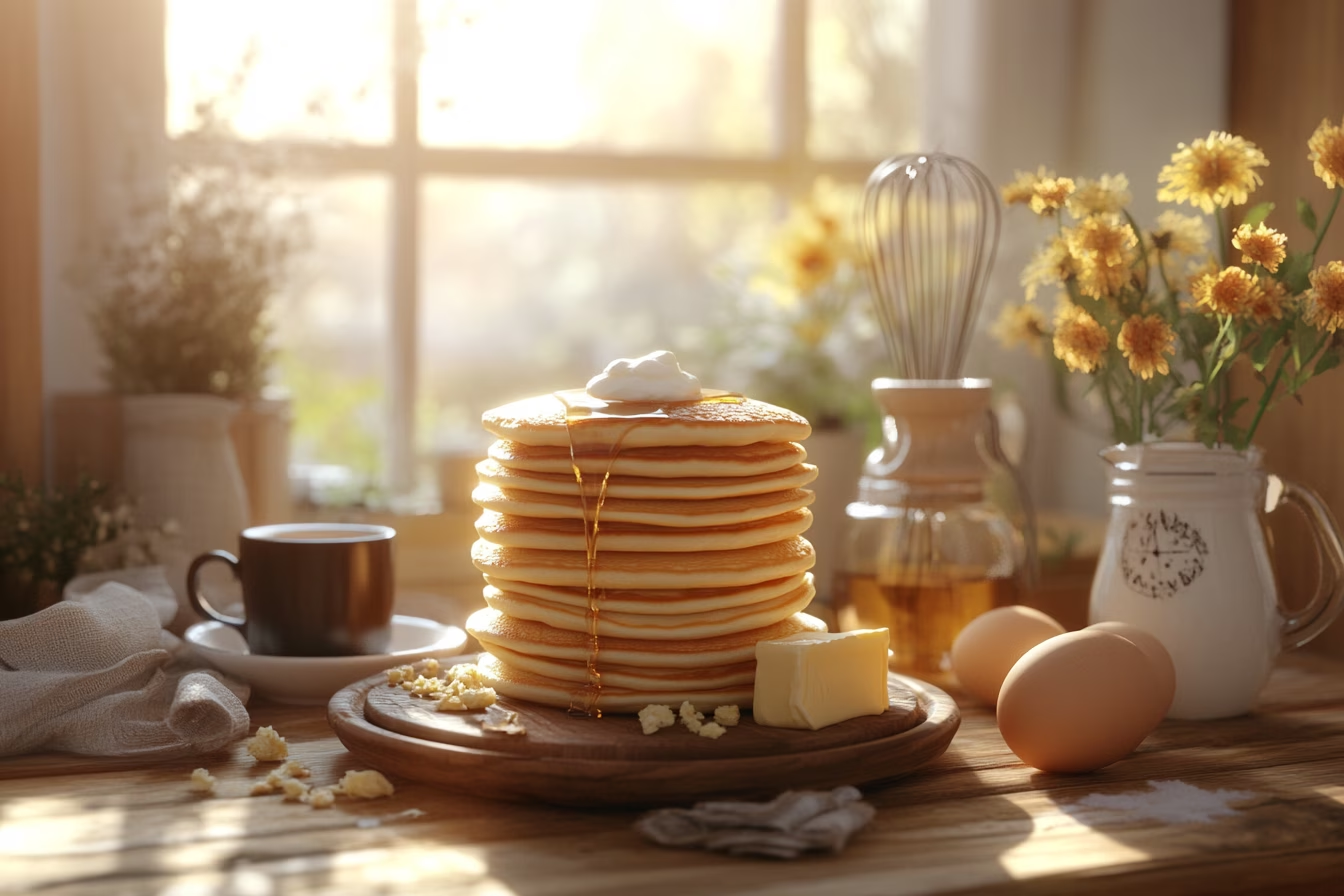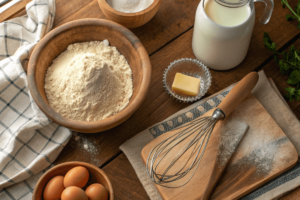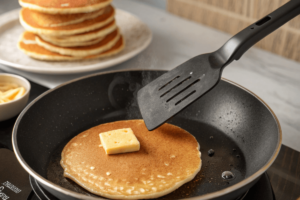Pancakes hold a special place in breakfast traditions worldwide. They’re simple yet versatile, capable of turning any ordinary morning into a delightful experience. But achieving that perfect pancake—the one that’s light, fluffy, and golden brown—often seems elusive. This article dives deep into the art and science of pancake perfection, unraveling the key techniques and tips to make every batch a success. Whether you’re a seasoned cook or a novice in the kitchen, you’ll find actionable advice to take your pancakes to the next level.
The Universal Appeal of Pancakes
It’s no exaggeration to say that pancakes are beloved across the globe. From the fluffy, buttery stacks in America to the delicate crêpes in France, pancakes are a culinary chameleon, adapting to local flavors and traditions. In Japan, for instance, the soufflé pancake rises to towering heights, while in Ethiopia, injera—a sourdough flatbread—serves as both a dish and utensil.
But why are pancakes universally adored? They’re endlessly customizable, offering a blank canvas for sweet or savory toppings. Moreover, the shared experience of flipping and serving pancakes, often accompanied by family chatter, makes them more than just food—they’re comfort and connection on a plate.
The Quest for the Perfect Pancake
Despite their simplicity, pancakes can be deceptively tricky to master. Why do so many of us struggle to make them just right? The common culprits include batter that’s too runny or overmixed, uneven cooking, or using outdated leavening agents.
But take heart—these issues aren’t insurmountable. A few tweaks to your ingredients, technique, and timing can make all the difference. Whether you’re aiming for a stack that’s fluffy, crispy-edged, or perfectly tender, understanding the fundamentals will set you up for success. So, grab your whisk and get ready to uncover what makes the perfect pancake a reality.
Essential Ingredients for Perfect Pancakes
The foundation of a great pancake lies in its ingredients. Each component contributes uniquely to the texture, flavor, and appearance. Understanding these basics ensures you’re off to the best start.
Flour Selection
Flour serves as the backbone of your pancakes, and the type you choose makes a significant difference. All-purpose flour is a versatile choice, offering a balance between structure and tenderness. For those aiming for a hearty, nutty flavor, whole wheat flour is a fantastic option, though it may yield slightly denser pancakes. On the other hand, cake flour delivers an ultra-soft and tender texture, ideal for melt-in-your-mouth results.
While experimenting with flours, keep in mind their gluten content. Too much gluten leads to chewy pancakes, while too little can cause them to fall apart. Balance is key.
The Role of Leavening Agents
Leavening agents like baking powder and baking soda are the secret behind pancakes that rise beautifully. Baking powder, a combination of acid and base, creates carbon dioxide bubbles when it reacts with liquids and heat. This process makes your pancakes fluffy and airy.
Baking soda, on the other hand, requires an acidic component like buttermilk or yogurt to activate. It works quickly, so once your batter is mixed, cook it promptly to harness its full potential.
Importance of Fresh Ingredients
Fresh ingredients can make or break your pancakes. Using fresh baking powder is crucial since it loses its potency over time. To test its freshness, add a spoonful to warm water—if it fizzes, it’s good to go. Similarly, check your other pantry staples like flour and baking soda to ensure peak quality. After all, every small detail counts when aiming for perfection.
Learn more about how fresh ingredients impact pancake quality at Williams-Sonoma.
The Science Behind Fluffy Pancakes
Mastering the science of pancakes elevates them from ordinary to exceptional. By understanding the roles of key ingredients and techniques, you can control the outcome with confidence.
The Role of Eggs
Eggs are a powerhouse ingredient in pancake recipes, offering structure, moisture, and fluffiness. The protein in eggs binds the batter, giving your pancakes the right amount of stability. Meanwhile, the fat in the yolks adds richness and tenderness.
For even lighter pancakes, some recipes separate the eggs, whipping the whites into stiff peaks before folding them into the batter. This adds an extra lift and cloud-like texture.
The Impact of Mixing Techniques
When it comes to mixing, less is definitely more. Overmixing the batter activates the gluten in the flour, resulting in dense, rubbery pancakes. Instead, stir the ingredients just until combined—lumps in the batter are perfectly fine and often preferred.
Mixing techniques also influence how air is trapped in the batter. Gentle folding helps retain the leavening bubbles, ensuring your pancakes remain soft and airy. By paying attention to these details, you’ll avoid the pitfalls of overworked batter.
Preparing the Pancake Batter
Creating the perfect pancake begins with properly preparing the batter. From balancing ingredients to allowing the batter to rest, each step contributes to pancakes that are fluffy, golden, and delicious. Let’s break it down.
Wet and Dry Ingredients
One of the most critical steps in making pancake batter is mixing the wet and dry ingredients separately before combining them. This method ensures even distribution and minimizes the risk of overmixing, which can make pancakes tough.
Start by whisking together the dry ingredients—flour, sugar, baking powder, baking soda, and salt—in a large bowl. In a separate bowl or measuring jug, blend the wet ingredients, such as eggs, milk, melted butter, or oil, along with any flavoring like vanilla extract. By keeping them separate, you can better control the texture and consistency when you mix the two together.
When it’s time to combine, create a well in the center of the dry ingredients and pour in the wet mixture. Stir gently with a whisk or spatula until the ingredients are just combined. It’s perfectly fine if the batter looks a little lumpy—those lumps often make for lighter pancakes.
Achieving the Right Consistency
The batter’s consistency plays a pivotal role in the final texture of your pancakes. Aim for a thick, pourable batter that flows smoothly but isn’t runny. If the batter is too thin, your pancakes may spread too much and cook unevenly. Conversely, overly thick batter can lead to dense, heavy pancakes.
To adjust the consistency, you can add small amounts of milk to thin it out or a sprinkle of flour to thicken it. Remember, the batter should coat the back of a spoon but not drip off too quickly. This balance ensures the pancakes hold their shape while cooking and achieve that soft, fluffy texture we all love.
Letting the Batter Rest
Patience is a virtue, even in pancake-making. Allowing the batter to rest for 10 to 15 minutes before cooking gives the flour time to hydrate fully, and the leavening agents get a chance to activate. This rest period helps reduce gluten development, resulting in a tender, airy pancake.
Additionally, resting allows any trapped air bubbles to settle, giving the batter a smoother, more consistent texture. Skipping this step often leads to pancakes that are less fluffy and unevenly cooked. So, resist the urge to rush—good things come to those who wait.
Learn more about achieving the perfect batter consistency at King Arthur Baking.
Recipe for Perfect Pancakes
Ingredients:
- Dry Ingredients
- 1 cup all-purpose flour
- 2 tbsp sugar
- 1 tsp baking powder
- 1/2 tsp baking soda
- 1/4 tsp salt
- Wet Ingredients
- 1 egg
- 3/4 cup milk (or non-dairy alternative)
- 2 tbsp melted butter or neutral oil
- 1 tsp vanilla extract
Instructions:
- Mix Dry Ingredients: In a large bowl, whisk together the flour, sugar, baking powder, baking soda, and salt.
- Mix Wet Ingredients: In a separate bowl, whisk the egg, milk, melted butter, and vanilla extract.
- Combine: Create a well in the center of the dry ingredients, pour the wet mixture in, and stir gently until just combined. Do not overmix; lumps are okay.
- Rest the Batter: Let the batter rest for 10–15 minutes.
- Preheat Pan: Heat a non-stick skillet or griddle over medium heat. Lightly grease with butter or oil.
- Cook Pancakes: Pour 1/4 cup of batter onto the pan. Cook until bubbles form and edges are set, then flip and cook for an additional minute or two.
- Serve: Stack the pancakes and serve warm with your choice of toppings.
Nutritional Information (Per 100g)
| Nutrient | Amount |
|---|---|
| Calories | 220 kcal |
| Protein | 6 g |
| Carbohydrates | 30 g |
| Fat | 8 g |
| Saturated Fat | 4 g |
| Sugar | 7 g |
| Fiber | 1 g |
| Sodium | 300 mg |
The Perfect Cooking Surface
Enhancements and Variations
The beauty of pancakes lies in their versatility. Beyond the basic recipe, you can introduce exciting flavors and tailor them to various dietary preferences. Let’s explore creative ways to elevate your pancakes.
Flavor Additions
Incorporating Fruits and Nuts
Adding fruits and nuts to pancake batter is a delicious way to infuse natural sweetness and texture. Popular options include blueberries, bananas, or apple chunks, which soften beautifully as they cook. Scatter them onto the batter after pouring it onto the pan for even distribution.
For a crunchy twist, consider chopped walnuts, pecans, or almonds. Toasting the nuts lightly beforehand enhances their flavor. Be sure to fold these additions gently into the batter to avoid overmixing.
Using Spices and Extracts
Spices and extracts can completely transform the flavor profile of your pancakes. A dash of cinnamon adds warmth, while nutmeg lends an earthy depth. For a burst of citrus, try zesting a lemon or orange into the batter.
Vanilla extract is a classic choice for enhancing sweetness and aroma. For adventurous cooks, consider experimenting with almond extract or even a hint of rum extract (alcohol-free options available) for a sophisticated twist.
Dietary Modifications
Gluten-Free Options
For gluten-free pancakes, substitute all-purpose flour with alternatives like almond flour, coconut flour, or gluten-free all-purpose mixes. These flours bring unique textures and flavors but may require adjustments in liquid ratios due to differences in absorbency.
Using oat flour is another excellent option—it creates hearty, fluffy pancakes and pairs well with fruity toppings.
Vegan Substitutions
Making pancakes vegan is simpler than it seems. Replace eggs with alternatives such as flaxseed meal mixed with water or mashed bananas. For milk, opt for almond, soy, or oat milk, which work well without compromising flavor.
For butter, plant-based margarine or coconut oil can do the trick. Vegan pancakes can be just as delicious and satisfying as traditional ones when paired with thoughtful toppings.
Serving Suggestions
Once your pancakes are cooked to perfection, the real fun begins. From classic toppings to decadent syrups and sides, the possibilities are endless.
Toppings and Syrups
Classic Toppings
The simplest toppings often deliver the most nostalgia. A generous drizzle of maple syrup, a pat of butter, or a handful of fresh fruits like strawberries or blueberries can make pancakes shine.
Powdered sugar dusted lightly over the stack creates a beautiful finish and adds a hint of sweetness.
Gourmet Enhancements
Take your pancakes to new heights with gourmet toppings. Add a dollop of whipped cream, a sprinkle of toasted nuts, or even a swirl of chocolate sauce. Specialty syrups like honey, caramel, or fruit compote turn an ordinary stack into a dessert-worthy creation.
For a savory twist, top pancakes with cream cheese or a thin layer of peanut butter paired with sliced bananas.
Explore gourmet topping ideas and inspirations at Williams-Sonoma.
Accompaniments
Pairing pancakes with sides and beverages creates a complete, satisfying meal.
Side Dishes
For hearty breakfasts, serve pancakes alongside scrambled eggs, sausages, or even a side of sautéed vegetables. These combinations balance the sweetness of pancakes with savory elements.
For lighter sides, yogurt topped with granola or a fresh fruit salad works wonderfully.
Beverage Pairings
Pair your pancakes with beverages that complement their flavor. Coffee or black tea enhances the rich, buttery notes of classic pancakes. For a refreshing contrast, consider freshly squeezed orange juice or a berry smoothie.
Whether enjoyed with a morning latte or an energizing fruit drink, the right pairing elevates the pancake experience.
Troubleshooting Common Issues


